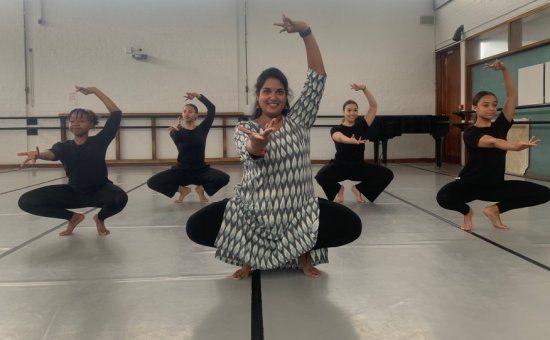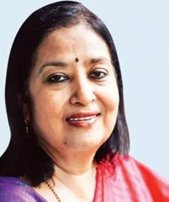
|   |

|   |
The struggle of another kind - Chitra Mahesh e-mail: chithoo@gmail.com January 13, 2024 One the sessions that stood out in the Natya Darshan 2023 under the auspices of Kartik Fine Arts and curated under the guidance and mentorship of Prof Sudharani Raghupathy and Chitra Visweswaran, was by Saranya Devan, Indian by birth and raised in Durban, South Africa. With a Masters in Bharatanatyam from the University of Madras and another one from the University of Cape Town, her passion is for looking out for new voices, ideas and innovative methods to narrate stories and courageous enough to go beyond and transcend boundaries. She is a guest lecturer in Theatre and Dance, University of Cape Town and currently registered for a PhD - subject being 'The Obliteration of Indian Performing Arts- with special focus on classical Indian dance in South Africa.' It remained etched in memory primarily because she spoke about Apartheid, segregation , being brown and about being a pioneer of sorts in a land where Mohandas Karamchand Gandhi began the first few movements towards Freedom and Liberation. Her journey sounded bitter sweet as she threw light on how it all happened. According to her, the South African Indian community comprises 3 per cent of the national population, economically and in terms of academic advancement. It is even harder that the "South African Indians appear to be dispensable in the eyes of the government.'' They don't seem to be part of the 'colours' defining the term 'Rainbow Nation', first coined by Archbishop Desmond Tutu to showcase and describe Post-Apartheid South Africa in 1994. In this context, time and distance along with political climate have all contributed to Bharatanatyam becoming what she terms "meaningless movements". The Indian settlers she says, brought with them their native arts and forms such as the Therukoothu but Bharatanatyam only made its advent in the late 1940s. Showing images of the first pioneers in this style, one of them was Ongra Devi Sharda Naidoo who came from Hyderabad. Sharda Naidoo had attended the Madras Seva Sadanam Boarding School in Chetput, in Madras and then married a Durban-based businessman, Jayraman Naidoo and settled in South Africa in 1947. At that time, the Indian dance culture was at its lowest. With her opening the first Indian dance school at the Hindu Tamil School in Durban in 1951, she started with teaching Telugu and Bharatanatyam. Soon it became something many middle and working-class Indians taking to it for themselves and as part of their tradition down the line. The first batch of South African women who left to study in the then Madras, included Salochana Naidoo who left in February 1959. Around the same time, the Nydoo sisters Rani and Prema went to Madras to learn at the Saraswathi Gana Sabha and had performed before Prime Minister Jawaharlal Nehru. Salochana, Rani and Prema were the first to learn a complete Bharathanatyam Margam. Jayalakshmi Naidoo, after initially taking lessons from Sharda Naidoo, further trained under Dr. Thirupurasundrie and later with Dr. Padma Subrahmanyam. Kumari Ambigay Pillay (now Nepaul) who travelled in 1966, spent 4 years learning dance, Tamil language and music. Krish Swamivel Pillay, a cousin of Ambigay, also studied dance in Madras for a brief period. The next batch of teachers to train in India included (Saranya's first guru) Yogambal Singaram. Other young dancers from KwaZulu-Natal included Vasugi Singh, Manormani Govender, Kantharuby Munsamy, Vanitha Phillips, Paranjyothi Naicker, Vyjayantimala Naidoo and Suriyakumari Govender. From the Cape Province, Savitri Naidoo travelled to India and learnt under Indra Rajan. All these dancers returned in the 1970s and opened their own dance schools mostly in and around Durban, with the exception of Savitri Naidoo who established a school in the predominantly Indian township of Rylands in Cape Town. Among those who went to India in the second wave, the late 1970s and early 1980s, were Jayesperi Moopen who learnt at Kalakshetra for five years and Maya Makanjee who also learnt Bharatanatyam in the then Bombay. After democracy came to South Africa in 1994, Indian dance continued to remain at the peripheral. Things seemed to be cruising along but somewhere it all plateaued out. Says Saranya, "Teachers were no longer critically involving themselves in teaching the art form. Instead it felt that the objective floats between superficially being a dedicated dance teacher and trying to make money. Bhakti had been lost. Given the low standard of teaching, the dance form collapsed into a worthless heap on stage because traditional rules have been abandoned here."  So why do Indian children learn Bharatanatyam? In South Africa which is what Saranya was talking about mostly, there seems to be a presumption within the Indian diaspora that by sending children to learn an Indian classical dance form like Bharatanatyam, rather than hip-hop or freestyle Western dance form, the child will be a cultured Hindu and embrace the values, attitudes and behaviour of the Indian motherland. While that may be so, democracy presented challenges - the Indian dancer had to embrace other cultures and their respective dance forms in the new, multicultural South Africa. According to Judge Jody Kollapen, South African Human Rights Commissioner, Indian dancers have to be open minded - they must straddle both an Indian and African identity. There still prevails among some conservative South African Indians the notion that Bharatanatyam will assist to retain an Indianness in a multilingual, multi-racial and multi-religious South Africa. On the other hand, many would also like to align with the new South Africa and want to embrace African-ness rather than be seen to be clinging to their Indian "roots". So why does departure from the traditional form hit her hard? "Some years ago, I had to abandon 'incorrect' posture and gestures and replace them with 'correct' movements. At my first meeting with Adyar Lakshman Sir, he asked me to perform a few adavus. Soon after I commenced, he promptly stopped me and advised that my Natyarambam needed to be corrected. Since old habits die hard, it took some practice to correct the wrong arm position to conform to what was regarded as perfect. On subsequent short trips to India, I would again be corrected for bad posture and for clumsy placement of adavus. My basic steps had never been corrected in Durban and I was allowed to progress to the dance repertoire, yet whenever I went back to India, I had to spend time working on basic steps, and this together with children far younger than me. I felt embarrassed and humiliated. I could have easily continued progressing through the various items for a Margam and would have had my arangetram in South Africa years ago. However, deep inside I knew that what I had been taught and what I learnt fell far short of the required standard by reputable schools in Chennai. I put my arangetram on hold and began lessons in Chennai which meant unlearning and relearning the adavus and even the basics of talam. There is physical and emotional impact when as an adult in your late 20s, you have to take baby steps. However, for me dance is more than meaningless movements. My postures and gestures must conform to a standard in keeping with traditional guidelines. Thus the shame of having to unlearn steps and to condition my mature limbs was worth all the effort because I now know that I possess a technique that is true to the traditional dance form, also thanks now to my guru Priya Murle. Reviving a dying art form is a collective effort. By combining passion with the support of like-minded individuals, artists, organizations, and the broader community, one can make a significant impact in preserving and revitalizing Bharatanatyam. The community needs to be re-educated about Bharatanatyam's importance through workshops, seminars, talks, and presentations.  As a South African Indian woman, based in Cape Town, South Africa in 2023, I have been questioning my identity as a Bharatanatyam dancer in the context of dance and 'Indian Performing arts' in this country South Africa that I call home. What can be done to ensure Bharatanatyam has a rightful place on the cultural agenda and attains a stripe in the Rainbow? I have begun my personal journey... to reworking/revitalizing Indian dance in a small way. I have been working with students from different racial and cultural backgrounds such as Africans, White and Coloured (mixed race) on dance and drama projects where I have taken Indian dance and theatre techniques and reworked the pedagogy to see how it can be used in this type of space. Two recent examples of my work among University of Cape Town theatre and dance students were a successful workshop on Navarasas and a performance in public at a Diwali festival which showcased the students performing kollatam with a minute long Bharatanatyam segment."  Chitra Mahesh is a senior journalist based in Chennai. |